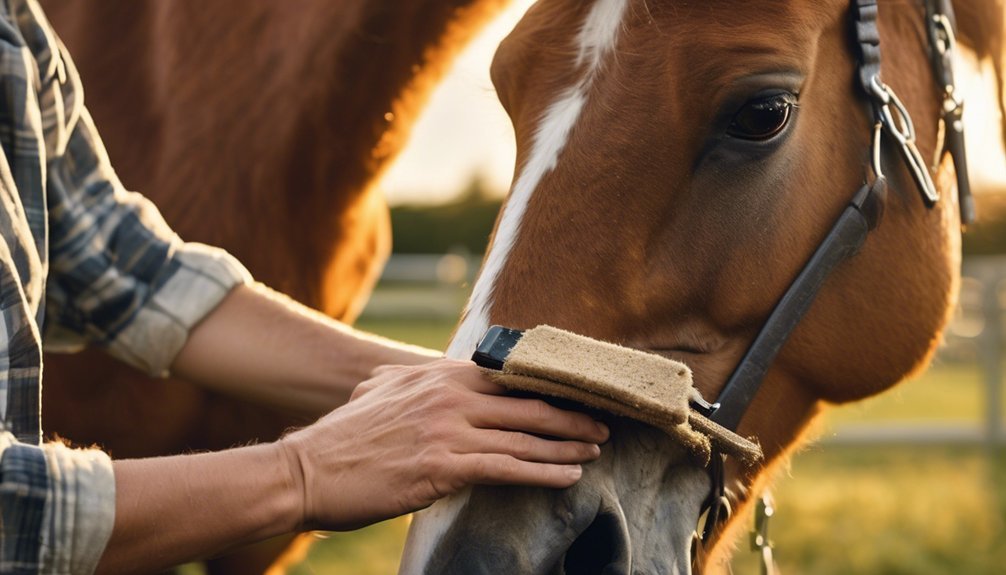
Horse mites can wreak havoc on your horse's health, causing irritation and hair loss that might seem unbearable. To effectively prevent and treat these pests, you'll need to understand their types, symptoms, and the environments that foster infestations. By implementing a regular grooming routine and maintaining clean living conditions, you can significantly reduce the risk of a mite outbreak. But what happens when prevention isn't enough?
Key Takeaways
- Maintain clean living conditions by regularly cleaning stables, removing droppings, and changing bedding to reduce mite habitats.
- Establish a consistent grooming routine to monitor for signs of mites and strengthen the bond with your horse.
- Use appropriate topical treatments like insecticidal shampoos and consult a veterinarian for persistent mite issues.
- Ensure stable ventilation and avoid overcrowding to minimize environmental factors that contribute to mite infestations.
- Implement early intervention strategies to address symptoms promptly and enhance overall horse health and comfort.
Understanding Horse Mites: Types and Symptoms
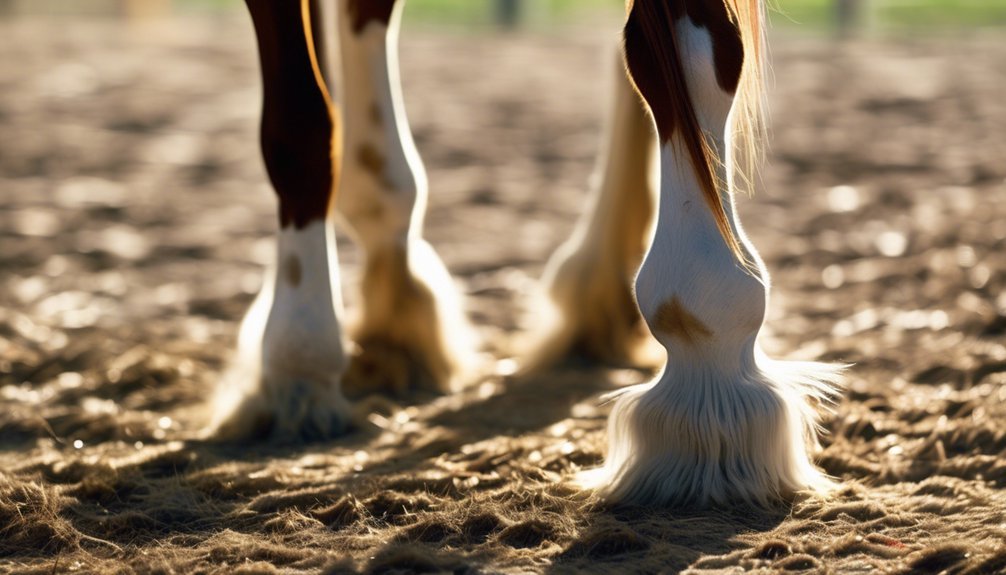
When it comes to understanding horse mites, recognizing the types and symptoms is crucial for effective management.
There are mainly two types of mites affecting horses: Sarcoptes scabiei, responsible for mange, and Chorioptes bovis, which causes irritation and inflammation.
Symptoms often include intense itching, hair loss, and skin lesions.
Understanding the mite life cycle is essential; these parasites reproduce quickly, leading to infestations if left unchecked.
Adult mites burrow into the skin, laying eggs that hatch into larvae within a week, perpetuating the cycle.
By being aware of these types of mites and their symptoms, you can act swiftly, ensuring your horse remains comfortable and healthy.
Monitoring your horse regularly will help you identify any issues before they escalate.
Identifying High-Risk Environments for Mite Infestations
Identifying high-risk environments for mite infestations is vital in preventing outbreaks among horses. Pay close attention to high traffic areas, such as barns, paddocks, and wash racks, where multiple horses congregate. These locations create ideal conditions for mites to spread.
Shared facilities also pose a significant risk; when horses come into contact with common equipment, bedding, or grooming tools, they can easily transfer mites. Additionally, environments with poor ventilation and high humidity levels can encourage mite proliferation.
Regularly assess these spaces for cleanliness and mite activity. By understanding where mites thrive, you can take proactive measures to protect your horses and minimize the risk of infestations, ensuring their health and comfort.
Regular Grooming: A Key Preventative Measure

Regular grooming is essential for maintaining your horse's health and preventing mite infestations. By establishing a consistent grooming routine, you can effectively monitor your horse's skin and coat, ensuring any issues are caught early.
To achieve optimal results, consider the following:
- Choose the right grooming tools: Use brushes and combs designed for your horse's coat type.
- Increase grooming frequency: Aim for daily grooming sessions, especially during high-risk seasons.
- Check for signs of mites: Pay attention to any unusual irritations or hair loss.
These practices not only help keep mites at bay but also strengthen your bond with your horse, ensuring they feel loved and cared for.
Regular grooming is a proactive step towards long-term health and happiness.
Maintaining Clean Living Conditions for Your Horse
Maintaining clean living conditions for your horse is crucial not only for their overall health but also for preventing mite infestations.
Start with bedding selection; choose absorbent materials like straw or wood shavings that minimize moisture and odor. Regularly change the bedding to prevent the accumulation of waste and parasites.
Additionally, ensure proper stable ventilation. Good airflow helps reduce humidity and keeps the environment dry, making it less hospitable for mites. Open windows or install vents to promote circulation, especially in warmer months.
Regularly clean the stable, removing droppings and soiled bedding daily. By prioritizing these practices, you'll create a healthier space for your horse, significantly reducing the risk of mite infestations while nurturing their well-being.
Dietary Considerations to Boost Your Horse's Immunity
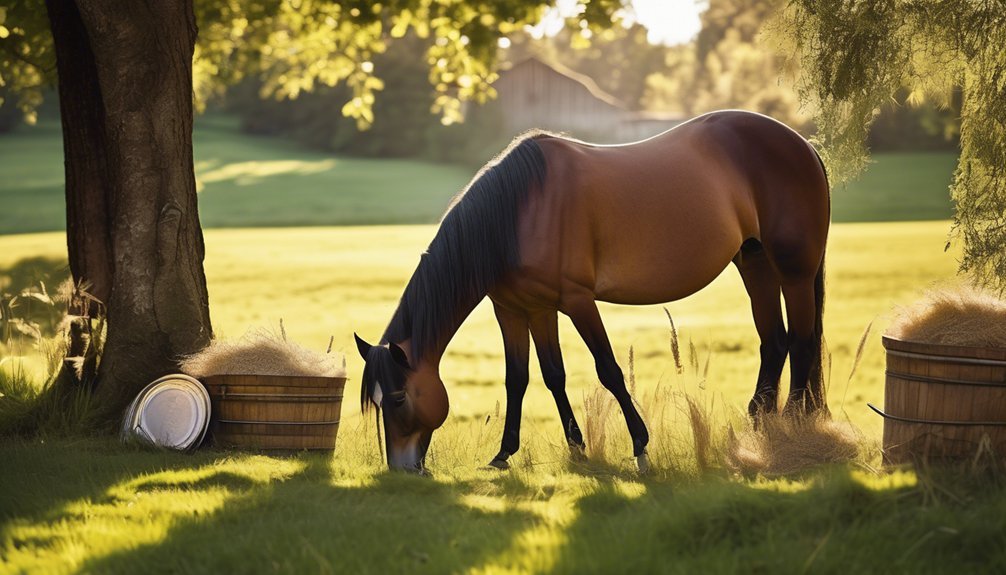
To effectively boost your horse's immunity, it's essential to focus on a balanced diet rich in essential nutrients. Incorporating specific immunity boosters can make a significant difference in your horse's overall health.
Ensure your horse's diet includes:
- High-quality forage for fiber and vitamins
- Omega-3 fatty acids for anti-inflammatory support
- Nutritional supplements like probiotics and antioxidants
These components help strengthen your horse's immune system, making it more resilient to mites and other health issues.
Pay attention to the quality of the feed and consider adding nutritional supplements that specifically target immune health. A well-rounded diet not only supports immunity but also enhances your horse's vitality and well-being, ensuring they remain active and healthy in their environment.
Using Mite-Repellent Products Effectively
While you may have already strengthened your horse's immunity through diet, using mite-repellent products effectively is crucial for preventing infestations.
Start by selecting natural repellents that suit your horse's skin type. Essential oils like lavender and eucalyptus are excellent choices.
When applying, use proper techniques: spray from a distance of about 12 inches to ensure even coverage while avoiding skin irritation. Focus on areas where mites commonly hide, such as the mane, tail, and underbelly.
Don't forget to reapply after rain or heavy sweating, as efficacy can diminish. Regular grooming also helps distribute the repellent and keeps an eye out for any signs of mites.
Consistency in your approach will create a formidable barrier for your horse against these pests.
Recognizing Early Signs of Mite Infestation
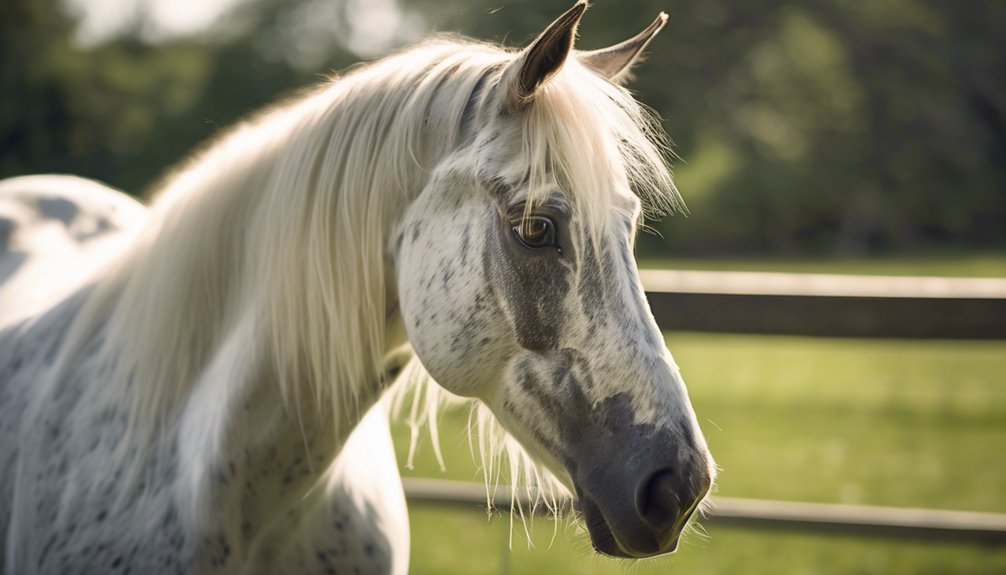
Recognizing early signs of mite infestation can make all the difference in protecting your horse's health and comfort.
Pay close attention to your horse's behavior and physical condition, as early symptoms can manifest in subtle ways. Look for:
- Excessive scratching or rubbing against objects
- Changes in appetite or reluctance to exercise
- Unexplained shifts in temperament, such as increased irritability
These behavioral changes may indicate discomfort caused by mites.
Additionally, inspect your horse's skin for redness, swelling, or hair loss—these physical signs signify that the infestation may be worsening.
By being vigilant and observant, you can take action early, ensuring your horse remains happy and healthy.
Always trust your instincts; if something feels off, it's worth investigating further.
Steps to Take When You Suspect a Mite Problem
When you notice signs of a potential mite problem, swift action is vital to safeguarding your horse's well-being.
First, examine your horse's skin closely for any redness, itching, or hair loss, as these can indicate irritation caused by mites. Document any changes you see, as understanding the mite life cycle helps in identifying the extent of the infestation.
Next, enhance your horse skin care routine by bathing your horse with a gentle, anti-parasitic shampoo, which can help alleviate discomfort and remove any surface mites.
Ensure you clean and disinfect the stable environment, as mites thrive in dirty conditions.
Finally, consult with your veterinarian to discuss potential treatments and establish a plan moving forward, ensuring your horse remains healthy and comfortable.
Treatment Options: Topical and Systemic Solutions
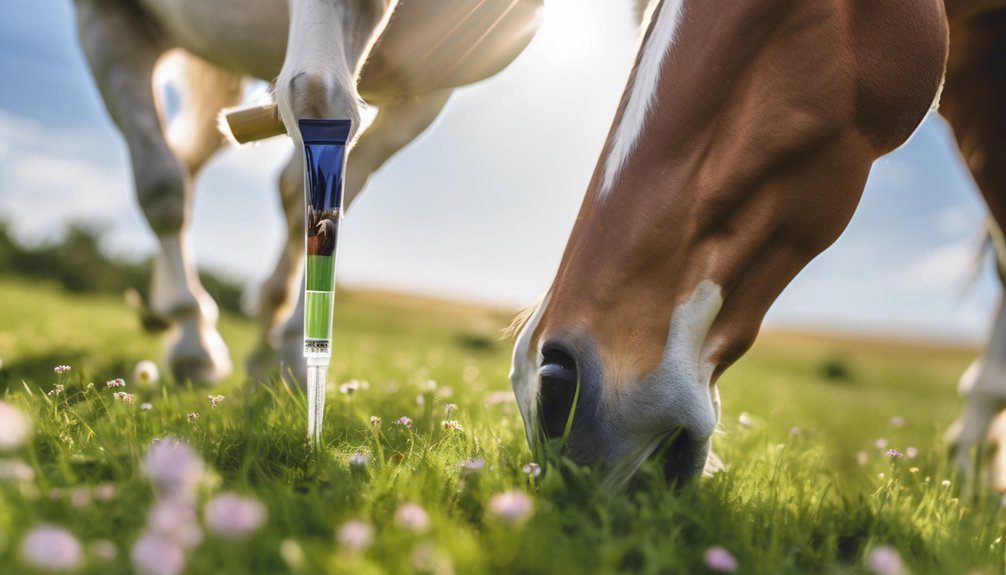
To effectively combat horse mites, you'll need to consider both topical and systemic treatment options that target these pests at various stages of their life cycle.
Topical treatments are often the first line of defense, applied directly to the affected areas. They can include:
- Insecticidal shampoos or sprays: These provide immediate relief by eliminating mites on contact.
- Ointments or creams: These can soothe irritated skin while delivering active ingredients to combat the infestation.
- Dusts or powders: Easy to apply, these can cover larger areas and provide longer-lasting protection.
Systemic medications, on the other hand, work from within your horse's body to eliminate mites.
These treatments are particularly effective for severe infestations, ensuring a thorough and comprehensive approach to mite management.
Consulting With a Veterinarian for Persistent Issues
Persistent mite infestations can be challenging to manage, even with the right topical and systemic treatments.
If you find that your horse's condition isn't improving, it's crucial to seek a veterinary consultation. An experienced veterinarian can provide expert advice tailored to your horse's specific needs.
They may recommend advanced diagnostic tests to identify underlying issues or suggest alternative treatments you mightn't have considered. Your vet can also guide you on proper environmental management, ensuring you eliminate the mites' habitat effectively.
Remember, timely intervention is key. By partnering with a veterinary professional, you're not just addressing the symptoms but working towards a long-term solution for your horse's health and comfort.
Don't hesitate to reach out for help when needed.
Frequently Asked Questions
Can Horse Mites Affect Other Animals or Humans?
Yes, horse mites can affect other animals and humans. Mite transmission occurs through direct contact or contaminated environments. Animal susceptibility varies, so be cautious, as these pests can cause discomfort and health issues beyond horses.
How Long Can Horse Mites Survive Without a Host?
Imagine these tiny warriors; horse mites can survive up to a week without a host. Their lifecycle hinges on host dependency, making them relentless in their quest for survival, ready to invade whenever opportunity strikes.
Are Certain Horse Breeds More Prone to Mite Infestations?
Certain horse breeds exhibit varying susceptibility to mite infestations due to genetic factors. You'll find that some breeds are more prone, so understanding these traits can help you manage and protect your horse effectively.
What Are the Long-Term Effects of Untreated Mite Infestations?
Have you ever wondered what happens when mite infestations go untreated? Long-term health issues can arise, including skin infections and severe discomfort, leading to behavioral changes that affect your horse's overall well-being and performance.
Can Stress in Horses Increase the Risk of Mite Infestations?
Yes, stress in horses can increase mite infestations. Effective stress management promotes overall health and immunity, which aids in mite prevention. Keeping your horse relaxed and comfortable is essential for reducing their vulnerability to these pests.
Conclusion
In managing horse mites, early action is crucial—did you know that nearly 30% of horses experience mite infestations at some point? By staying vigilant and implementing a consistent grooming routine, maintaining clean living conditions, and addressing any signs of discomfort promptly, you can significantly reduce the risk of these pests. Remember, consulting a veterinarian can provide tailored solutions that ensure your horse remains healthy and mite-free, safeguarding their comfort and overall well-being.





